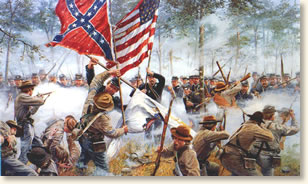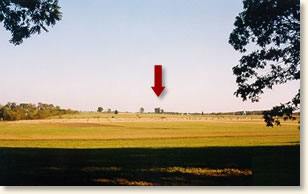|
Pickett's Charge, 1863
It was carnage incarnate. Often described as the "high water mark" of the Confederate cause during the Civil War, Pickett's Charge has also come to represent the naked brutality of combat. It occurred on July 3, 1863, the third and final day of the Battle of Gettysburg that ravaged the outskirts of a small town in central Pennsylvania. Frustrated by two days of inconclusive struggle, General Robert E. Lee decided to hurl his forces at the center of the Union line, with the objective of breaking through and thus setting the stage for the piecemeal destruction of his enemy.
 |
Confederate and Union troops collide
at the conclusion of "Pickett's Charge"
|
The description of the Confederate attack as "Pickett's Charge" is misleading on two counts. First, Major General George Pickett was the commander of only one of the three Confederate units that took part in the assault. Major General Isaac R. Trimble and Brigadier General J. Johnston Pettigrew each commanded a unit of the attack. The second misconception is with respect to describing the Confederate assault as a "charge." The assault line of the approximately 12,500 Confederate soldiers engaged in the attack extended a half-mile in width. The hapless attackers were required to advance one mile through an open field and over a stone fence before they could engage their enemy. The majority of this distance was covered at a rank-and-file walk while Union troops poured deadly cannon and rifle fire upon them. The Confederates could not fire back. The Union troops, however, maintained a murderous hail of rifle fire by organizing themselves into efficient lines of four soldiers. After the first in line fired, he would move to the back of the line to reload his weapon while the next in line fired.
The impact of this efficient killing machine on the approaching Confederates was devastating. As their comrades fell, their units would reorganize and tighten their ranks. Smoke from the cannonade from both sides soon drifted over the field dramatically reducing visibility. The noise was deafening. As they approached withina a few feet of the Union line, the Confederates charged. Some were able to scale the low stone wall separating them from their enemy, but the devastating fire from the Union troops forced a retreat. The battle was over.
“. . .the grand march moved bravely on.”
Confederate General James Longstreet was second in command to Robert E. Lee during the battle. It was his responsibility to convey the order (which he did not agree with) to General Pickett. We join his story on the battlefield as the artillery duel fills the air with cannon fire and General Pickett asks for instructions:
"Pickett said, 'General, shall I advance?'
The effort to speak the order failed, and I could only indicate it by an affirmative bow. He accepted the duty with seeming confidence of success, leaped on his horse, and rode gayly to his command. I mounted and spurred for Alexander's post. He reported that the batteries he had reserved for the charge with the infantry had been spirited away by General Lee's chief of artillery; that the ammunition of the batteries of position was so reduced that he could not .use them in proper support of the infantry. He was ordered to stop the march at once and fill up his ammunition-chests. But, alas! there was no more ammunition to be had.
The order was imperative. The Confederate commander (General Lee) had fixed his heart upon the work. Just then a number of the enemy's batteries hitched up and hauled off, which gave a glimpse of unexpected hope. Encouraging messages were sent for the columns to hurry on, - and -hey were then on elastic springing step. The officers saluted as they passed, their stern smiles expressing confidence. General Pickett, a graceful horseman, sat lightly in the saddle, his brown locks flowing quite over his shoulders. Pettigrew's division spread their steps and quickly rectified the alignment, and the grand march moved bravely on. As soon as the leading columns opened the way, the supports sprang to their alignments. General Trimble mounted, adjusting his seat and reins with an air and grace as if setting out on a pleasant afternoon ride. When aligned to their places solid march was made down the slope and past our batteries of position.
 |
A modern-day photo of the "copse of trees"
taken from the start of the Confederate advance
|
Confederate batteries put their fire over the heads of the men as they moved down the slope, and continued to draw the fire of the enemy until the smoke lifted and drifted to the rear, when every gun was turned upon the infantry columns. The batteries that had been drawn off were replaced by others that were fresh. Soldiers and officers began to fall, some to rise no more, others to find their way to the hospital tents. Single files were cut here and there, then the gaps increased, and an occasional shot tore wider openings, but, closing the gaps as quickly as made, the march moved on. . .
Colonel Latrobe was sent to General Trimble to have his men fill the line of the broken brigades, and bravely they repaired the damage. The enemy moved out against the supporting brigade in Pickett's rear. Colonel Sorrel was sent to have that move guarded, and Pickett was drawn back to that contention. McLaws was ordered to press his left forward, but the direct line of infantry and cross-fire of artillery was telling fearfully on the front. Colonel Fremantle ran up to offer congratulations on the apparent success, but the big gaps in the ranks grew until the lines were reduced to half their length. I called his attention to the broken, struggling ranks. Trimble mended the battle of the left in hand¬some style, but on the right the massing of the enemy grew stronger and stronger. Brigadier Garnett was killed, Kemper and Trimble were desperately wounded; Generals Hancock and Gibbon were wounded. General Lane succeeded Trimble, and with Pettigrew held the battle of the left in steady ranks.
Pickett's lines being nearer, the impact was heaviest upon them. Most of the field officers were killed or wounded. Colonel Whittle, of Armistead's brigade, who had been shot through the right leg at Williamsburg and lost his left arm at Malvern Hill, was shot through the right arm, then brought down by a shot through his left leg.
General Armistead, of the second line, spread his steps to supply the places of fallen comrades. His colors cut down, with a volley against the bristling line of bayonets, he put his cap on his sword to guide the storm. The enemy's massing, enveloping numbers held the struggle until the noble Armistead fell beside the wheels of the enemy's battery. Pettigrew was wounded, but held his command.
 |
Major General George Pickett
|
General Pickett, finding the battle broken, while the enemy was still reinforcing, called the troops off. There was no indication of panic. The broken files marched back in steady step. The effort was nobly made, and failed from blows that could not be fended. . .
Looking confidently for advance of the enemy through our open field, I rode to the line of batteries, resolved to hold it until the last gun was lost. As I rode, the shells screaming over my head and ploughing the ground under my horse, an involuntary appeal went up that one of them might take me from scenes of such awful responsibility; but the storm to be met left no time to think of one's self. The battery officers were prepared to meet the crisis, - no move had been made for leaving the field. . . Our men passed the batteries in quiet walk, and would rally, I knew, when they reached the ridge from which they started.
General Lee was soon with us, and with staff-officers and others assisted in encouraging the men and getting them together."
References:
This eyewitness account was originally published in: Longstreet, James, From Manassas to Appomattox (1896), republished in Hart, Albert Bushnell (ed.) American History told by Contemporaries vol. 4 (1928);
Reardon, Carol, Pickett’s Charge in History and Memory (1997); Sears, Stephen W., Gettysburg (2003).
How To Cite This Article:
"Pickett's Charge, 1863" EyeWitness to History, www.eyewitnesstohistory.com (2010).
|






